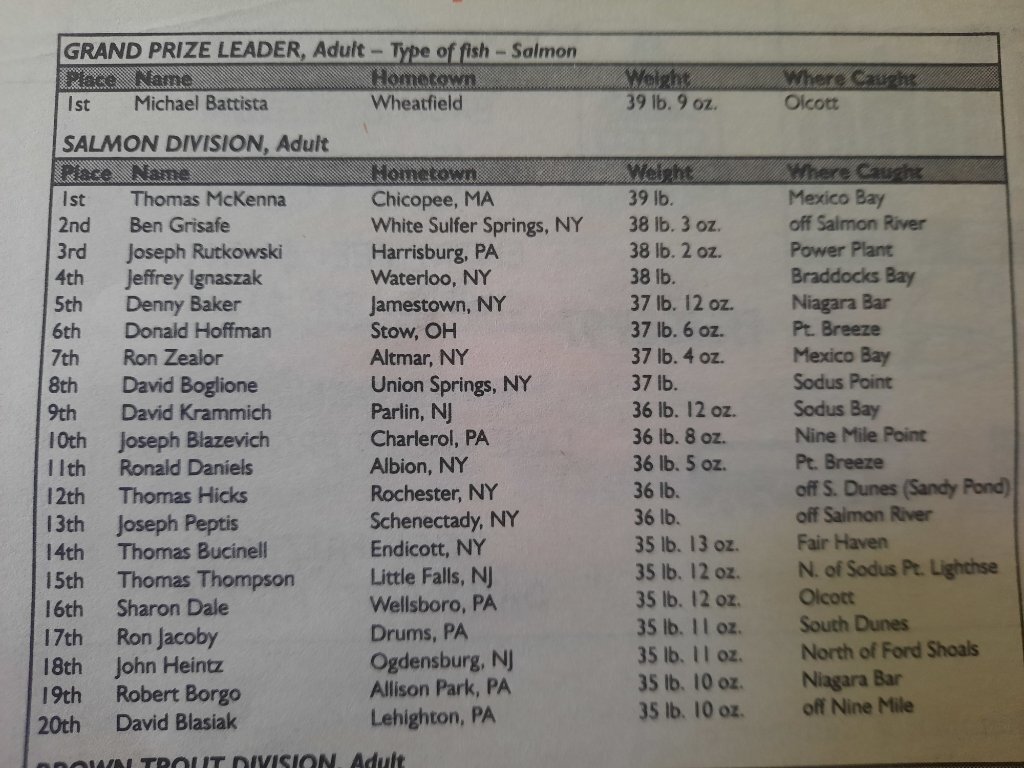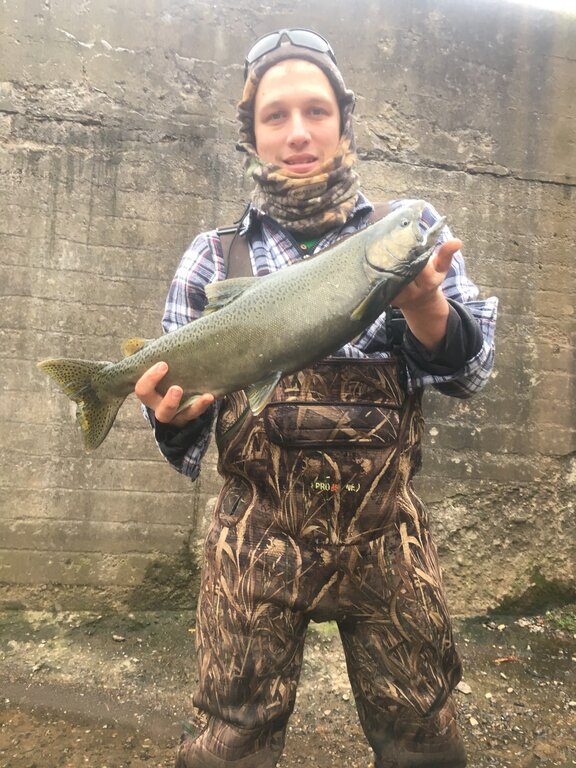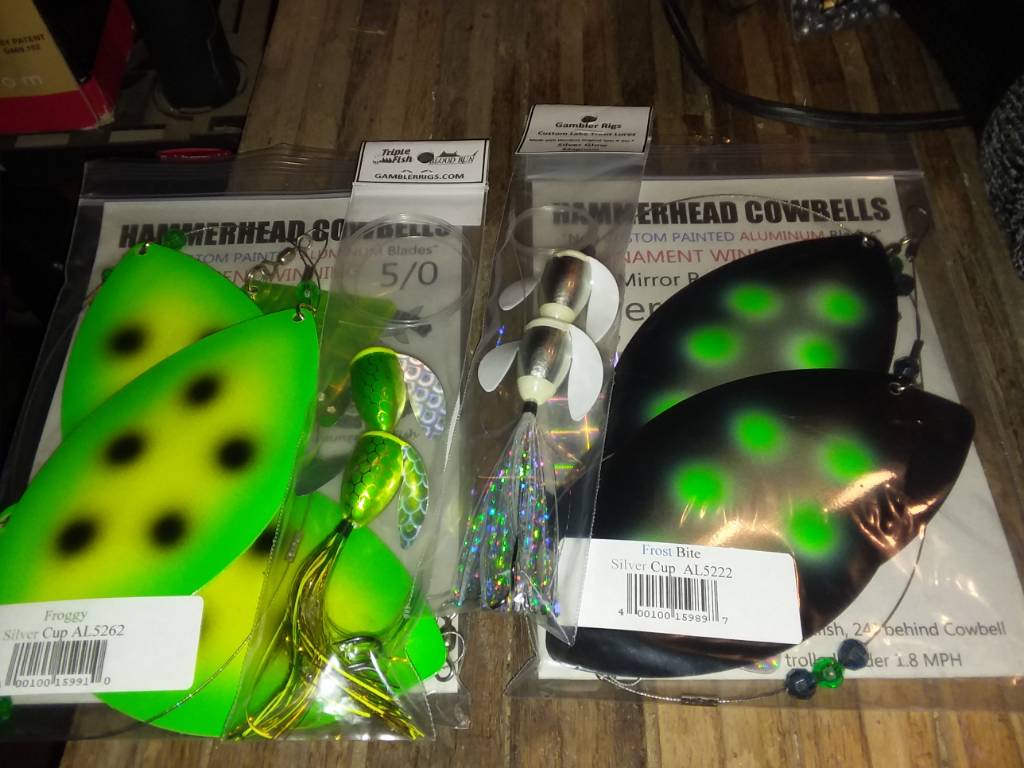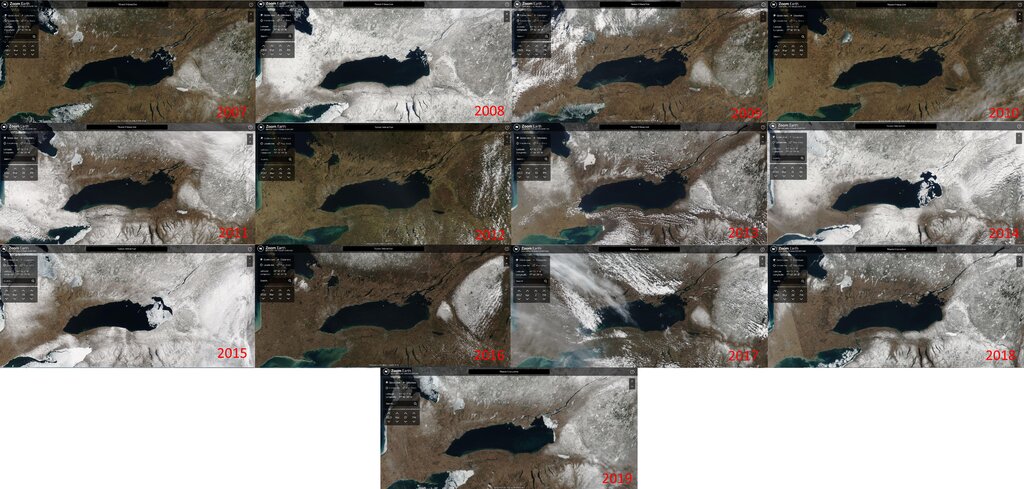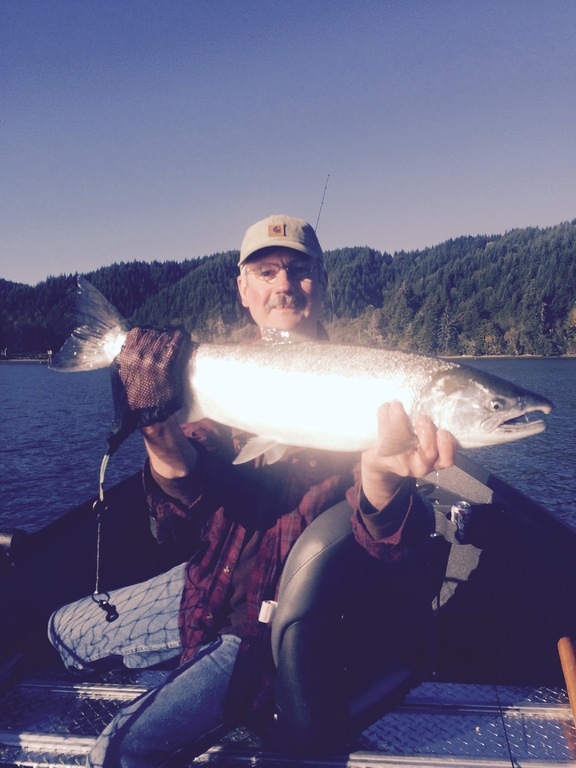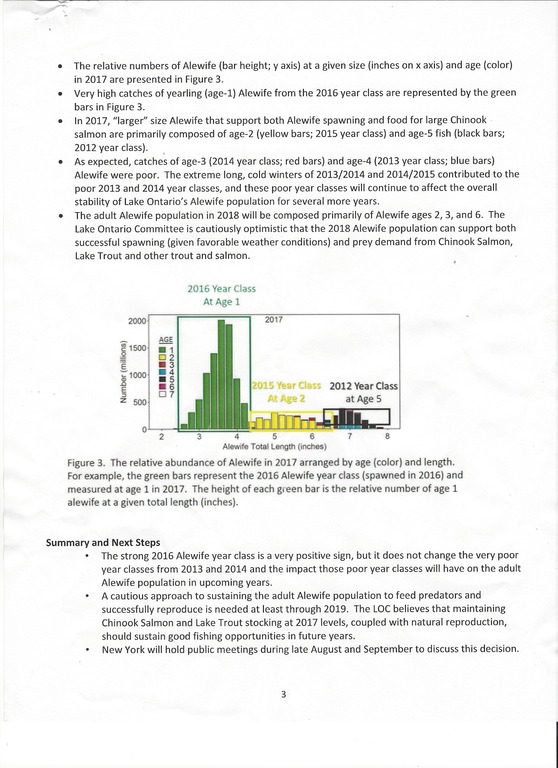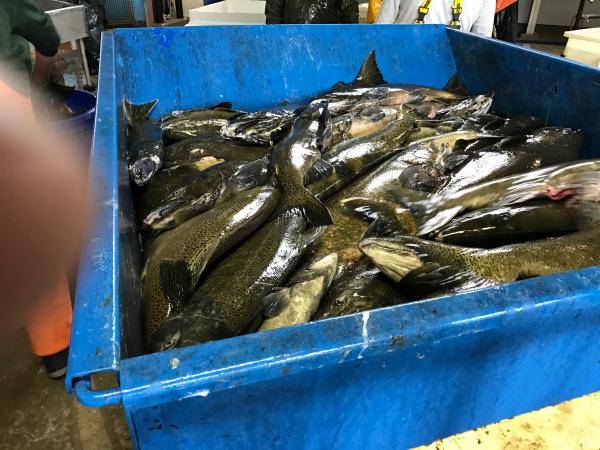

ut_falcon
Members-
Posts
55 -
Joined
-
Last visited
Content Type
Profiles
Forums
Events
Gallery
Store
Everything posted by ut_falcon
-
Interesting thing is although the worldwide average temperature may be increasing the temperature trend in eastern North America is actually flat, you can find this in the literature about climate change online but the media doesn't like to report on it since it's not a catchy story they can sell. Have a look at maximum ice cover on Lake Ontario since the mid 80's its actually pretty consistent with cold and warm years but overall trend is flat. We're still feeling the after effects of the cold winters in 2014/2015 in my opinion as we had 30# salmon hitting the boards in 2010, 2011, 2012, 2013. Michigan had a size rebound so don't know about natural selection for size being a factor since they can still produce a 47 pound king. There seems to be a fair amount of bait still in the lake so I don't know what's going on really, I thought we'd see bigger fish this year based on the last few winters.
-

What size are the Shakers right now
ut_falcon replied to schreckstoff's topic in Open Lake Discussion
Was out on saturday north shore near Cobourg and can confirm what Gill-T reports, lots of bait with few hooks and lots of shakers. bait was loaded from 30 to 100 fow. Riggers were shaking multiple times when running through the bait, did get two nice fish in the 20# range, should be back out Thursday. -
For what it's worth If you look at the 2018 YOY salmon river seining catch rate it was the lowest since 2008 and 2017 was average to slightly above. Added to the reduced stocking over the last 2 years it indicates we should see fewer fish next year but potentially more 4 year old fish. Lake Ontario was also hit harder proportionally by the winter of 2014/2015 than lake Michigan. It's possible that Michigan has recovered quicker than Ontario due to that, just a theory though, we'll see next year. It sounds like 2019 was a good hatch of wild salmon so it's not all doom and gloom but maybe a temporary reduction of fish in the lake for the next few years. But who knows, nature is a hard thing to predict sometimes, I'll be fishing either way. On another note the biggest salmon in 20 years were caught in lake huron and Georgian bay derbies this year so bait has definitely rebounded. its mostly smelt now in Georgian bay but lots of it marked in the last few years.
-

Just for your information UPDATED question # 2
ut_falcon replied to RUNNIN REBEL's topic in Open Lake Discussion
-

Just for your information UPDATED question # 2
ut_falcon replied to RUNNIN REBEL's topic in Open Lake Discussion
-

Just for your information UPDATED question # 2
ut_falcon replied to RUNNIN REBEL's topic in Open Lake Discussion
-
-

Just for your information UPDATED question # 2
ut_falcon replied to RUNNIN REBEL's topic in Open Lake Discussion
-
Here's an image I created showing end of march conditions for Lake Ontario going back to 2007. The images vary by a few days each year due to cloud cover I tried to pick the clearest image to show the year to year changes. Lots of ice in the north east corner of the lake this year but lots of rain over the weekend has it melting fast.
-

Another 20% CUT in Chinook Stocking for 2019
ut_falcon replied to Tall Tails's topic in Open Lake Discussion
The best fishing in years did not occur on the north shore of the lake, its pretty clear the conditions this year kept the majority of salmon on the south shore. I'm skeptical about another 20% cut being needed (40% total now) with no additional cuts to lakers. You can't argue depleted baitfish while pushing the laker numbers that just smells of an agenda. We are still seeing the effect of the cold winter on chinook size, let's see what happens next year. If size is up its because of the last few warm years and nothing to do with stocking cuts. -

Another 20% CUT in Chinook Stocking for 2019
ut_falcon replied to Tall Tails's topic in Open Lake Discussion
-

Another 20% CUT in Chinook Stocking for 2019
ut_falcon replied to Tall Tails's topic in Open Lake Discussion
The Huron/Ontario comparison is not valid, just look at the whitening event and algea blooms on Lake Ontario this year there's a massive amount of food for the baitfish this year. It doesnt sound like they are doing another 20% cut to lake trout. Chinook and lake trout cuts need to be done equally if only to show they are not favoring lakers. Does anyone know if that's the case? -

Another 20% CUT in Chinook Stocking for 2019
ut_falcon replied to Tall Tails's topic in Open Lake Discussion
-
I have not had the knots slip on 19 strand, I just use the standard wire knot. I haven't used roller guides or twili tip and very minimal wear to the eye after about 30 fishing trips. I only get out half dozen times a year so it works for me, if you're out all the time I could see the need for roller or twili.
-
List of introduced species to north america off the top of my head: honey bees, dogs, cats, sheep, cattle, horses. I wonder how many advocating for the removal of pacific salmon from the great lakes own a dog or cat. Pure stupidity in my opinion to advocate against such a successful program in the great lakes that brings joy to thousings and bring in millions to the local economy.
-
They've been saying michigan has bait issues much worse than ontario yet there have been numerous 30 pounders and a few over 40 caught this year and fish appear very fat. Obviously it's difficult to accurately measure the true baitfish population of the great lakes with thousands of square miles of surface area. I think being cautious is a good thing but if this hole in the population doesn't effect the Chinook population or average size, I think the models need to be adjusted. So far all I see is average water temperature and growing season that seem to effect the size and population and migration pattern of the Chinook.
-
Eastern basin on the Canadian side has commercial fishing for walleye and perch. Harvest of walleye is around 20,000 pounds per year, that doesn't include the additional harvest by native spearing and netting.
-
I was suprised to read they used to allow several million pounds per year of LIVE carp to be imported to the Toronto fish markets, this was banned in 2004. Just ridiculous that it took that long for a ban to be put in place, I'm sure there is still a black market going on importing these fish.
-
I fish the mid to eastern end of the lake, most of these tribs are not stocked and have wild runs of salmon. The ganaraska run seemed good / normal but some of the smaller tribs that normally get thousands of salmon had almost nothing due to low water at the river mouth. Other then last fall the last few years were excellent in the smaller tribs.
-
Good read on the issues at hand guys. We are in uncharted territory with two brutal back to back winters, we haven't seen that amount of ice cover on the lake since the introduction of the pacifics, so it makes sense there would be some weird repercussions. I believe these will be temporary changes, hopefully just a blip in the long run. We haven't been stocking the same levels of lake trout as Michigan and I think that's something to be thankful for. I'd argue that we've reduced the phosphorus levels in Lake Ontario too much as a result of the phosphorus controls put in place to bring the lake to a pre-industrialized level, combine that with the zebras and its reducing the lakes carrying capacity too much. I look to you guys from NY with a lot of respect in what's been done for the lake fishery, you have the stocking priorities on the right species and we've benefited from that in Canada. The politics in Ontario have warped things in the wrong direction in my opinion, we've devoted way too much of our resources to Lake Trout, Atlantic Salmon and now Deep Water Cisco restoration. I'd be fine with supporting a background level of these species but in Ontario we have 65% of our L.O. hatchery capacity devoted to those three species, again it’s way out of wack. To give you an idea, here is a statement taken from the Stocking Strategy for the Canadian Waters of Lake Ontario - https://www.ofah.org/wp-content/uploads/2016/02/Lake-Ontario-stocking-plan-2016.pdf “Native Species Restoration is the first priority of this Strategy. OMNRF will continue stocking native species to support fish community restoration under the direction of specific plans for species such as Atlantic Salmon, Lake Trout, Deepwater Cisco and Walleye, American eel and Lake Sturgeon.” As we all share the lake it’s important to know this is the guiding priority for at least the Canadian side of the lake. They also state that the sport fishery will be maintained but it’s not the primary concern of the stocking program, this seems backwards to me. Not be completely negative as there have been some positive changes in the last few years but there’s still a long way to go. I believe the fishery should be managed to provide the biggest return to the most amount of people, not just one or two special interest groups. But back to the rainbow situation, the numbers are down big time on the north shore as well, I did a couple trips to the blue zone last year and numbers were way down compared to 2-3 years ago. As King Davy mentioned the spring run on the ganaraska was down from an observed 8700 fish in 2013 to only 4000 last year. Very few fish around in the rivers this fall but that could be due to the lower water levels. The other great lakes don't seem to be having the same die off of rainbow that Lake Ontario is having. Here is an older report on lake Superior alewife growth rates but it has lake Ontario average growth rates as well (http://www.reabic.net/publ/Bronte_et al_1991.pdf) I was surprised to see how fast an alewife can grow, after hatching they grow to an average size of 3.5" by the fall and a 1 year old fish is on average 5.5". Two "missing" or low year classes would mean that the vast majority of alewife in the lake were 6-7", difficult for a smaller rainbow to eat and digest, higher thiaminase levels? did eating larger sized alewife contribute to the higher mortality rate of the last few years? There was also a surplus of an extra 360,000 steelhead stocked in 2010 & 2012 which seems to track the high returns to the ganaraska river, something to think about anyway.
-
Just throwing this out there but there seems to be a lot of hybridization between coho and chinook, does this produce a stile offspring like splake or other hybrids? Could the hatchery be accidently taking some sterile hybrids? Would love to see some skeena river steelhead added to the lake as well as seaforellen browns.
-

A discussion worth having. Gene Editing
ut_falcon replied to Sea Lion's topic in Open Lake Discussion
Georgian bay, part of lake huron has a self sustainting population of chinook that is supported by smelt and not alewife. Fish are smaller but the population is still healthy. Don't think the Chinook are going away anytime soon, decline in size and numbers maybe but short of targeted erratication effort they will be with us for a long time. The atlantic salmon program has a slim chance of success they are a more sensitive species for sure. I'm not againt catching them but we're tying up a lot of funding and effort that could be better used elsewhere in my opinion. Not to mention canadian management decisions are negatively impacting returns of rainbow and chinook to support a non existent atlantic salmon fishery. I don't understand the logic behind supporting native over naturalized species. Humans are part of the natural environment and ecosystems have constantly changed over time. We've accelated those changes in many cases but we are talking about successful sport fish that have high cultural and economic value, not an invasive pest species. Chinook are in some ways better adapted to our warmer rivers as they only spend a short time in the river system before smolting out to the lake. Coho, atlantics and rainbow spend longer in the river system and are more susceptible to high temperatures and droughts. Lake trout are obviously highly adaptable but suffer from poor natural reproduction and are not as desirable by the majority of anglers. Back to gene editing, I would support its use after thorough testing. It's probably the only plausible way to erraticate the zebras which would be benifical to most sportfish. Walleye and sheephead did well before their introduction so I still don't see any potential negative impact of their eradication. -

A discussion worth having. Gene Editing
ut_falcon replied to Sea Lion's topic in Open Lake Discussion
No I don't so. The zebras are trapping a large portion of nutrients that could be (and was in the past) available to game fish higher on the food chain. Pretty much everything did better before the zebra mussles invaded. Would you rather have that biomass available as baitfish or as zebra mussle? I know what I would choose. You can argue if alewifes are a good food source but I can't see any positive impacts from zebra mussle. -
I grew up on Georgian bay and the salmon were never as big as lake ontario, 36 pounds was the biggest fish officially recorded. I remember big schools of alewifes showing up in the spring lots of gulls feeding on them. There are still small numbers of alewife around but now it's the smelt populations that support the salmon fishery. Good numbers of salmon are still around and lots of natural reproduction, its not all gloom and doom. Lots of fish in the 15 pound range are caught while the derby winner is usally mid 20s now instead of low 30s. The smelt are smaller then the alewifes so you're not going to see the bigger fish anymore but still good days fishing to be had and the population is stable. I was up there a few years ago and the run was bigger then I ever remember.
-
Up on the north shore kingston area they have taken over all the islands and killed off most of the trees. In the laSt two years new colony's have moved to the shorelines killing off more tree and taking over the few good spots to fish from shore. In the spring box nests are placed on some of the island, I'd assume for some of the other bird species but the cormorants take them over. Great to see our government helping to spread their population. There was a bill introduced to allow hunting but haven't heard much about it lately. Hope a couple of raccoons get released on those islands, they have no predators to contol the numbers.

